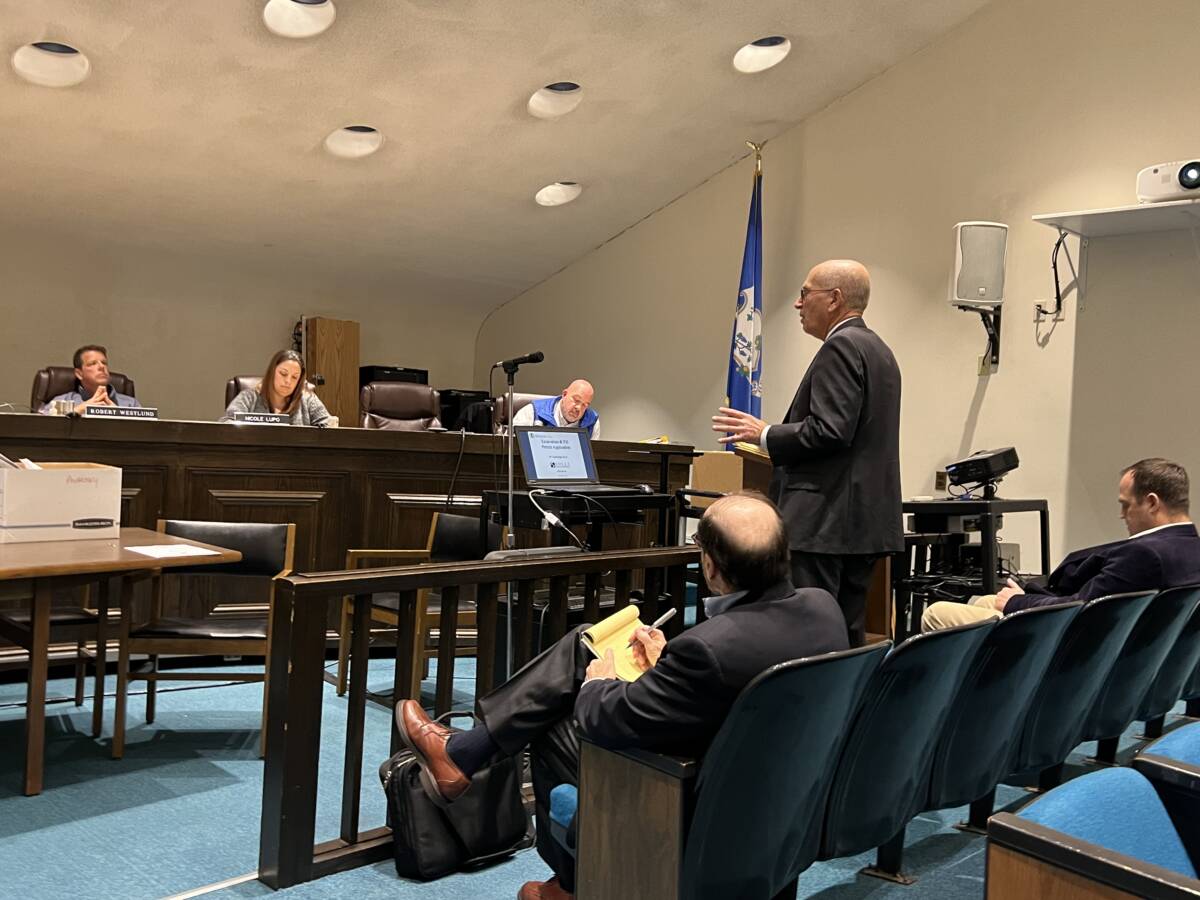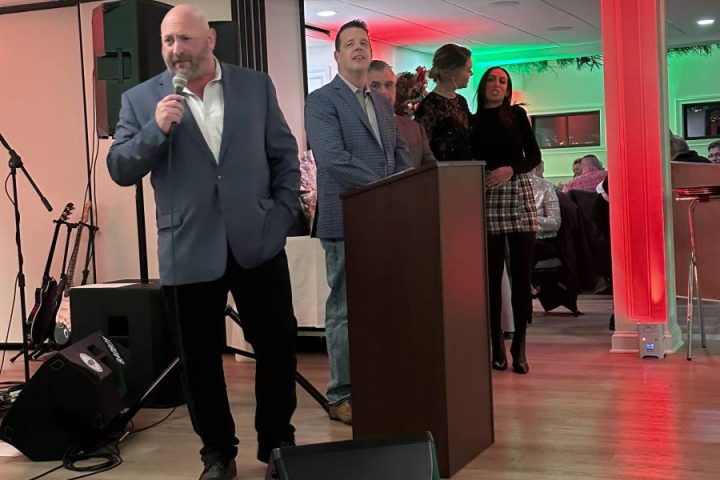MONROE, CT — A Planning and Zoning Commission approval of an excavation and filling permit for 64 Cambridge and 4 Independence drives will allow work to continue on a plan to restore wetlands destroyed by a quarrying operation conducted by the previous owner.
The commission’s previous approval of a permit was overturned by Fairfield District Superior Court Judge Dale W. Radcliffe, because it included waivers, which he said could only be approved by the Zoning Board of Appeals. The applicant recently obtained the waivers from the ZBA and came back to the commission with a second application.
“We’re voting on the same approval from the last time,” Planning and Zoning Commission Chairman Michael O’Reilly said during the hearing last Thursday.
Secretary Ryan Condon made a motion to approve the permit, which was seconded by Vice Chairman Bruno Maini.
The permit was approved by a vote of 4 to 1 with O’Reilly, Maini, Condon and Robert Westlund in favor and Leon Ambrosey opposed.
During deliberations, Condon noted how recent tests of the groundwater on the site were clean and O’Reilly said, “we don’t monitor groundwater routinely on excavation and fill permits and the activity is above the waterline.”
Ambrosey expressed concern over a trace amount of acetone, a manufactured chemical that is used as a sealer around windows, but that can also be naturally occurring.
O’Reilly said the latest commission approval still includes the town’s own licensed environmental professional to inspect the site.
“I’ve always been concerned about the groundwater,” Ambrosey said, adding the town’s expert from EnSafe did not test the water. “I’m a firm believer if you’re gonna bring in clean fill, the groundwater should be tested. We’re on wells here.”
O’Reilly said the applicant is monitoring the materials brought onto the site.
“I don’t see why it’s a problem to monitor the groundwater,” Ambrosey said. “That’s where I stand on it.”
‘A re-blessing’
Arnold Karp, who heads two LLCs that own the properties, says he wants to restore the wetlands, while eventually making the industrially zoned parcels viable for development.
On Thursday, Attorney Steve Finn, who represents the applicant, reminded the commission that their new application is identical to the one they had approved with the exception of the waivers.
Finn said protocols were followed after the first permit had been approved and reminded commissioners that their own independent expert from EnSafe issued a report saying there were no problems with the fill brought in.
He asked for a “re-blessing” of the permit.
Ambrosey had asked for additional testing of the groundwater at the previous meeting. Though not required to, to be open and transparent Finn said his client had six tests done on two different dates.
“We submitted the test results,” he said, adding while it had to be done in a shorter time period, all six tests came back fine. “There is no evidence there will be environmental damage from this permit,” he said.
Kevin Solli, principal of Solli Engineering in Monroe, said the groundwater was tested on Nov. 30 and Dec. 5. “The water is as clean as it was before,” he said. “I think this commission did a good job establishing strict regimented requirements that were followed.”
Nicole Lupo, a commission alternate, thanked the applicant for doing the testing.
Ambrosey noted that Darrick Jones, the licensed environmental professional for the applicant, had said there was a trace of acetone in one sample. Ambrosey said he has a concern with that.
Acetone can be a naturally occurring chemical and Solli noted there was only a trace amount.
“You’re not going to bring in any metal are you? Concrete with rebar in it?” Ambrosey asked.
“If recycled concrete is brought to the site it would be handled in accordance with previously approved protocols,” Solli said.
O’Reilly later said bringing concrete with rebar onto the property will not be permitted in the future.
“You don’t plan on bringing in any asphalt?” Ambrosey asked.
Solli said no.
“My only concern is that this site stays safe and the groundwater stays safe,” Ambrosey said, adding he has no problem with filling in a large hole left from the quarrying operation, which he said needs to be done.
When the applicant was before the Inland Wetlands Commission, Finn said the commission hired Russell Dirienzo, principal geologist and a licensed environmental professional for Arcadis in Sandy Hook, as an independent expert who “found the impacted area to be very small compared to the entire watershed.”
Finn also recalled that Aquarion Water Co. visited the site and expressed no concerns.
He said the Connecticut Department of Energy and Environmental Protection is the agency that could require testing for contaminants in water. “You’re talking about potential harm and not actual harm,” Finn said.
“My concern is you hit groundwater on a GAA site. It looked like a lake,” Ambrosey said.
“That water was tested,” Finn replied.
A brand new application
Peter Metropoulos, who owns a neighboring property at 36 Timothy Hill Road, says he is concerned over groundwater quality. He was the one who appealed the last approval and he filed for intervenor status for the hearing on the new permit application.
Intervenor status allows citizens to participate in a hearing, reviewing information submitted and including presentations by their own experts.
Though the Planning and Zoning Commission previously approved an excavation and fill permit, Joel Z. Green, the attorney for the intervenor, argued that the hearing was for a brand new application, so the applicant could not simply resubmit the materials from the previous one.
“This application stands on its own,” Green said. “The existing conditions are not what they were two years ago,” he added, noting how much of the property was filled in since the last application. “This should reflect present conditions and not conditions from 18 months ago.”
Green said the contours of the property are not the same and all drawings and maps must be current. He said zoning regulations require site plans and surveys for excavation and filling permits.
By using the same data, Green said, “the application is defective out of the box, because it doesn’t reflect current conditions of the site.”
“At the end of the day, all my client wants is to assure that the groundwater is clean,” he said, while wondering why the commission had argued that Metropoulos should have tested his own water, which Green said does not seem to be what the regulations require.
Green said site testing and monitoring should be required on an ongoing basis, while fill is brought onto this site.
“I think we’re ready to close the hearing,” Solli said. “We do provide a plan that shows the current topography. This plan is in six phases and it will be back. We’re not going anywhere. We will continue to go by conditions that were approved.”
All respectful comments with the commenter’s first and last name are welcome.






